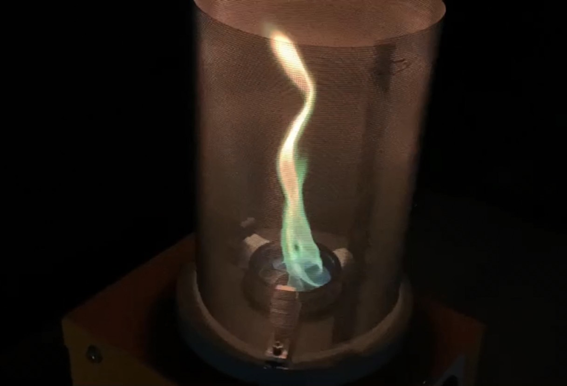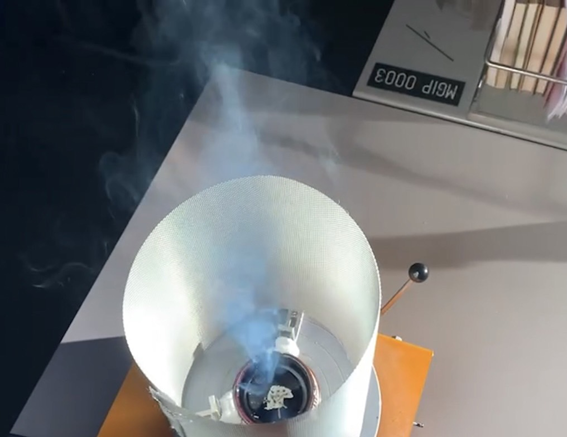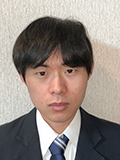Newsletter 2022.3 Index
Theme :"The Conference of Fluid Engineering Division (March issue)"
|
The charm of the flame whirlwind
|
1. Introduction
We six third-year students in the Kumagai Laboratory, Department of Mechanical Engineering, Faculty of Science and Engineering, Meisei University, participated in the 19th Nagare no Yume Contest held on demand on YouTube from November 8 to November 10, 2021, under the team name "Pooh Family. In that contest, we won the "Ichiju Award".
2. Concept
The theme of this year's 19th Dream of Flow Contest was "Fascinating! The beauty of the flow".
The theme of this year's contest was "Fascinating!
We first thought about what would be beautiful and attractive. The idea we came up with was to focus on light objects such as mirror balls and illuminations. However, we could not come up with an idea on how to connect electric light and fluid.
So we tried replacing the glowing object with fire. Using the famous phenomenon of fire, the flame whirlwind, we changed the color of the flames to create a beautiful work that looks like an illumination and looks good on video.
3. The work
The first step in creating a flame whirlwind is to divide the mechanism into the center of the actual burning fire and the air that rotates while supplying fresh oxygen to the center. Therefore, the first step was to create a device that could supply fresh oxygen.
What we came up with was a method of generating a flame whirlwind using an electric potter's wheel. We placed an ashtray in the center of the electric potter's wheel, lit it with ethanol, covered the ashtray with a wire mesh cylinder, and rotated the electric potter's wheel, and confirmed that a flame whirlwind was generated.

Figure1. A flame whirlwind being formed.
Since fire alone is boring, we wondered if it was possible to create other colors like fireworks.
So we tried to see if we could change the color of the fire using the flame color reaction, which we learned in chemistry class in high school.
First of all, the mechanism of the flame color reaction is that when a substance is burned, heat is added to the atoms, which increases their energy and causes the electrons to move outward. The electrons then try to return to their original position by emitting light as energy. This is how the color changes. Since the distance that the electrons move away varies depending on the element, the wavelength of the energy emitted differs, resulting in a different color. This is the mechanism of the flame color reaction.
When the aqueous solution used boils, the color changes and the boiling point differs as shown above.
Based on these facts, we were able to confirm the color difference by first using the flame color reaction experiment kit.
However, the boiling point of all of them exceeded 1000℃ except for the flame color reaction of boric acid. I tried to make a flame whirlwind with a gas burner for camping, but no flame whirlwind was generated. We decided that it would be dangerous to rotate something that was over 1000 degrees Celsius, so we decided to use a normal flame whirlwind, a flame whirlwind using boric acid, and a tornado created by using incense smoke to look like a flame whirlwind.

Figure2. Flamethrower with boric acid

Figure3. incense smoke
When we were experimenting with incense sticks, we had a question.
In the case of a normal flame whirlwind or a flame whirlwind with boric acid flame color reaction, the size of the flame whirlwind became smaller and less vigorous when the speed of the potter's wheel was slow, while the size of the flame whirlwind became larger and more vigorous when the speed of the potter's wheel was fast.
However, in the case of smoke, the opposite was true. When the speed of the wheel was increased, the smoke escaped from the wheel without forming a tornado like a flame whirlwind. When we slowed down the speed of the potter's wheel or braked from a fast speed, we could see the smoke vortex forming.
However, we could not understand why the smoke would form a vortex at a slower speed, unlike the flame.
So, since this is an on-demand show on YouTube, I decided to ask the question, "Why does smoke form a vortex when it rotates slowly, unlike a flame? I decided to ask the audience the question, "Why does smoke form a vortex when it rotates slowly, unlike flames?
I received an advice from an academic that it has to do with the strength of the updraft.
In creating the video, we took a different approach than in previous years, using an on-demand format on YouTube. In creating the structure of the video, we referred to the videos of many YouTubers that we usually watch, and added up-tempo music as background music so that third parties would not get bored.
4. Summary
This time, we went through a trial and error process, using a gas burner to test the flame color reaction before arriving at the creation of the flame whirlwind. After many failures, we arrived at the present work. We hope that this video will spark your interest in fluid engineering.
5. Final Thoughts
In participating in the 19th Nagare no Yume Contest, I would like to thank my colleagues in the laboratory for their cooperation and Dr. Kumagai, who has always been a great help to me in the laboratory. Thanks to them, I was able to receive the prestigious Ichiju Award.
I would also like to take this opportunity to express my deepest gratitude to the Japan Society of Mechanical Engineers (JSME) for allowing me to have such a valuable experience.


